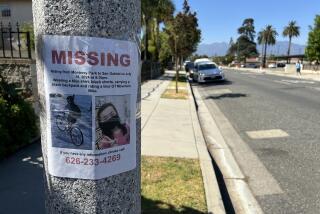Search for missing boy Etan Patz may have resumed
- Share via
NEW YORK — Gone are the quiet streets and the loading docks, replaced with hordes of shoppers ducking into stores selling scented body butter, premium denim and high-end furniture. But one thing remains unchanged on the narrow stretch of Prince Street in SoHo: the haunting memory of Etan Patz, a 6-year-old boy who left for school one morning in 1979 and never came back.
It is one of this city’s — and the nation’s — most chilling unsolved mysteries, a case many had forgotten or never knew about until Thursday, when police and FBI agents began searching the basement of a building on the same block as the little boy’s apartment.
Officials would not say exactly what led them to bring what one FBI agent called an “arsenal of equipment,” including a jackhammer, to the basement. “There have been a variety of elements … a variety of information and sources of information” that came together, said Special Agent Tim Flannelly of the FBI’s New York office.
Neighbors said they had seen at least one search dog brought to the building earlier in the week, and law enforcement officials confirmed that a dog had detected something in the basement. It was not clear whether the space had been scoured 33 years ago, after Etan’s disappearance on his way to a school bus stop prompted a shift in the country’s response to missing children.
The wide-eyed, shaggy-haired little boy became the first to appear on the side of a milk carton, part of the nationwide campaign to highlight the plight of missing and abducted children that evolved from Etan’s case and from his parents’ drive to keep it active.
“The disappearance of Etan Patz marked the birthplace of a movement,” said Ernie Allen, president of the National Center for Missing and Exploited Children.
Allen said it resonated partly because of the basic facts: A mom let her son walk two blocks by himself because he wanted to be like the big kids, and he vanished. Millions of parents thought “there but for the grace of God go I,” Allen said.
He credited Stan Patz, Etan’s photographer father, with creating an unforgettable “Missing” poster that captivated the nation. The boy’s eyes “just hone in on you,” Allen said. “It became an iconic image. In many ways, Etan was the first missing-child poster.”
Little is known of Etan’s last day except for a few details retold countless times by Stan and Julie Patz, who remain in the same building where they lived with Etan. On the morning of May 25, 1979, they granted his request to walk alone to the school bus stop for the first time. That was the last they saw of him.
“Did we do it too early? Obviously we did,” his father said in a 2009 television interview, eight years after Etan was declared legally dead.
No one was ever charged in the case. One investigator, and Stan Patz, became convinced that a convicted sex offender whose girlfriend baby-sat for Etan was responsible.
In 2004, a civil court ruled that the man, Jose Antonio Ramos, was responsible for Etan’s death, though criminal charges never were filed. Ramos, who is serving time in a Pennsylvania prison for child molestation, has denied involvement in Etan’s disappearance.
Early Thursday, police set up metal barricades to block the street where the search was underway. Word spread quickly among longtime residents who remembered when “Missing” posters went up on lampposts and telephone poles, and when police knocked on their doors looking for information.
“I’m trembling,” said Stephen Posen, a painter who was living in the then-edgy neighborhood back in 1979 with his family, including a girl Etan’s age.
“Any thought that my daughter would be allowed to walk by herself to the Little Red Schoolhouse was immediately shelved,” said Posen, who still lives in the neighborhood.
Three years later, Posen said, he and his wife began letting their daughter walk to school alone — but they secretly followed her.
“You always want closure, but it’s been so long, you assume nothing will resolve itself,” Posen said as onlookers, many of them tourists carrying shopping bags, watched the hive of police activity. “It was like into thin air.”
Sean Sweeney, director of the SoHo Alliance, also remembered the days after Etan vanished, and noted that it would have been easier for a child to disappear from the neighborhood back then. “There were no tourists. It was very peaceful. You had to walk blocks just to buy a newspaper,” he said.
At the time when Etan vanished — about 8 a.m. — the streets would have been quiet, Sweeney said. He credited the Patzes with keeping attention focused on Etan’s case, and on the cases of other missing children, calling their effort “the big bang” in the national movement.
On Thursday, the couple remained out of sight and did not issue any statements. However, the New York Police Department sent out a copy of the original “Missing” poster that helped spark a search that still goes on.
“STILL MISSING,” it read in red, capital letters, with two pictures of Etan. “LOST CHILD ETAN PATZ.”
Times staff writer Steve Padilla in Los Angeles contributed to this report.
More to Read
Sign up for Essential California
The most important California stories and recommendations in your inbox every morning.
You may occasionally receive promotional content from the Los Angeles Times.














